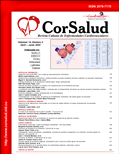Coexistent ventricular preexcitation and Brugada sign: A rare condition
Abstract
The coexistence of ventricular preexcitation and Brugada syndromes is very rare, no relationship has been established between them and so far they are considered separate diseases. Both are arrhythmogenic, can cause sudden death and their treatment is difficult; since some drugs used to prevent tachycardia can cause a Brugada sign. We present two patients with common characteristics: absence of structural heart disease demonstrable by conventional methods, frequent and symptomatic orthodromic tachycardias, ventricular pre-excitation and Brugada sign (both evident and intermittent), without clinical malignant ventricular arrhythmias; which is why programmed electrical stimulation was not performed to try to provoke them. Some singularities are discussed, such as the association of intranodal and orthodromic reentrant tachycardias in the patient in whom accessory pathway ablation was performed, and the difficulty of the therapeutic approach in the patient who did not agree to undergo the procedure.
Downloads
References
1. Eckardt L, Kirchhof P, Johna R, Haverkamp W, Breithardt G, Borggrefe M. Wolff-Parkinson-White syndrome associated with Brugada syndrome. Pacing Clin Electrophysiol. 2001;24(9 Pt 1):1423-4. DOI: https://doi.org/10.1046/j.1460-9592.2001.01423.x
2. De Roy L, Popescu E, Floria M, Blommaert D, Deceuninck O, Collet B, et al. Variable morphologies of preexcitation due to a concomitant Brugada pattern. J Interv Card Electrophysiol. 2007;20(1-2):39-41. DOI: https://doi.org/10.1007/s10840-007-9166-1
3. Jaiswal A, Heretis K, Goldbarg S. Coexistent Brugada Syndrome and Wolff-Parkinson-White Syndrome: What is the Optimal Management? Indian Pacing Electrophysiol J. 2013;13(5):173-7. DOI: https://doi.org/10.1016/s0972-6292(16)30669-6
4. Kaiser E, Sacilotto L, Darrieux F, Sosa E. Coexistence of Wolff-Parkinson-white and Brugada syndrome: mere curiosity? Ann Noninvasive Electrocardiol. 201;19(5):504-7. DOI: https://doi.org/10.1111/anec.12124
5. Bodegas AI, Arana JI, Vitoria Y, Arriandiaga JR, Barrenetxea JI. Brugada syndrome in a patient with accessory pathway. Europace. 2002;4(1):87-9. DOI: https://doi.org/10.1053/eupc.2001.0201
6. Aksan G, Tezcan M, Çevrim Ö, Elitok A, Bilge AK. Coexistence of Brugada and Wolff Parkinson White syndromes: A case report and review of the literature. Turk Kardiyol Dern Ars. 2018;46(6):488-93. DOI: https://doi.org/10.5543/tkda.2018.77834
7. Erdoğan O. Coexistence of Wolff-Parkinson-White and Brugada ECG. Turk Kardiyol Dern Ars. 2018;46(6):433-4. DOI: https://doi.org/10.5543/tkda.2018.75271
8. Khazan B, Curl K, Ho R. Brugada Pattern With a Concurrent Accessory Pathway. JACC Clin Electrophysiol. 2017;3(8):911-2. DOI: https://doi.org/10.1016/j.jacep.2016.11.004
9. Márquez MF, Cárdenas M. La controversia de la utilidad de la estimulación ventricular para la estratificación de riesgo en el síndrome de Brugada. CorSalud [Internet]. 2015 [citado 4 Jun 2021];7(3):158-60. Disponible en: http://www.revcorsalud.sld.cu/index.php/cors/article/view/52/112
10. Dorantes Sánchez M, Trung Chinh P. Estimulación eléctrica programada del corazón en el síndrome de Brugada. Parte I: Una visión actual. CorSalud [Internet]. 2015 [citado 5 Jun 2021];7(1):46-51. Disponible en: http://www.revcorsalud.sld.cu/index.php/cors/article/view/11/11
11. Dorantes Sánchez M, Trung Chinh P. Estimulación eléctrica programada del corazón en el síndrome de Brugada. Parte II. Variaciones sobre un mismo tema. CorSalud [Internet]. 2015 [citado 5 Jun 2021];7(3):202-13. Disponible en: http://www.revcorsalud.sld.cu/index.php/cors/article/view/59/96
12. Belhassen B. Is quinidine the ideal drug for brugada syndrome? Heart Rhythm. 2012;9(12):2001-2. DOI: https://doi.org/10.1016/j.hrthm.2012.08.037
13. Viskin S, Wilde AA, Tan HL, Antzelevitch C, Shimizu W, Belhassen B. Empiric quinidine therapy for asymptomatic Brugada syndrome: time for a prospective registry. Heart Rhythm. 2009;6(3):401-4. DOI: https://doi.org/10.1016/j.hrthm.2008.11.030
14. Viskin S, Antzelevitch C, Márquez MF, Belhassen B. Quinidine: a valuable medication joins the list of 'endangered species'. Europace. 2007;9(12):1105-6. DOI: https://doi.org/10.1093/europace/eum181
15. Dorantes Sánchez M. Apunte histórico sobre la quinidina. CorSalud [Internet]. 2013 [citado 6 Jun 2021];5(4):361-5. Disponible en: http://www.revcorsalud.sld.cu/index.php/cors/article/view/474/883
Downloads
Published
How to Cite
Issue
Section
License
Authors who publish with this journal agree to the following terms:- Authors retain copyright and grant the journal right of first publication with the work simultaneously licensed under a Creative Commons Attribution License that allows others to share the work with an acknowledgement of the work's authorship and initial publication in this journal.
- Authors are able to enter into separate, additional contractual arrangements for the non-exclusive distribution of the journal's published version of the work (e.g., post it to an institutional repository or publish it in a book), with an acknowledgement of its initial publication in this journal.










